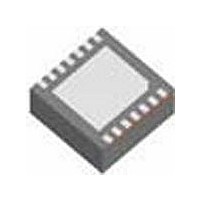LM4850LDX National Semiconductor, LM4850LDX Datasheet - Page 11

LM4850LDX
Manufacturer Part Number
LM4850LDX
Description
Manufacturer
National Semiconductor
Datasheet
1.LM4850LDX.pdf
(20 pages)
Specifications of LM4850LDX
Operational Class
Class-AB
Audio Amplifier Function
Headphone/Speaker
Total Harmonic Distortion
1@32Ohm@95mW%
Single Supply Voltage (typ)
3/5V
Dual Supply Voltage (typ)
Not RequiredV
Supply Current (max)
7@5VmA
Power Supply Requirement
Single
Rail/rail I/o Type
No
Single Supply Voltage (min)
2.4V
Single Supply Voltage (max)
5.5V
Dual Supply Voltage (min)
Not RequiredV
Dual Supply Voltage (max)
Not RequiredV
Operating Temp Range
-40C to 85C
Operating Temperature Classification
Industrial
Mounting
Surface Mount
Pin Count
14
Package Type
LLP
Lead Free Status / Rohs Status
Not Compliant
Typical Performance Characteristics
Non-LD Specific Characteristics
Application Information
BRIDGED AND SINGLE-ENDED OPERATION
As shown in Figure 1, the LM4850 contains three operational
amplifiers (A1-A3). These amplifiers can be configured for
SE or BTL modes.
In the SE mode, the LM4850 operates as a high current
output dual op amp. A1 and A3 are independent amplifiers
with an externally configured gain of A
outputs of A1 and A3 are used to drive an external set of
headphones plugged into the headphone jack. Amplifier A2
is shut down to a high output impedance state in SE mode.
This prevents any current flow into the mono bridge-tied
load, thereby muting it.
In BTL mode, A3 is shut down to a high impedance state.
The audio signal from the RIGHT IN pin is directed to the
inverting input of A1. As a result, the LEFT IN and RIGHT IN
audio signals, V
input of A1. A2 is then activated with a closed-loop gain of A
and A2 are then used to drive the mono bridged-tied load.
EXPOSED-DAP PACKAGE PCB MOUNTING
CONSIDERATION
The LM4850’s exposed-DAP (die attach paddle) package
(LD) provides a low thermal resistance between the die and
the PCB to which the part is mounted and soldered. This
allows rapid heat transfer from the die to the surrounding
PCB copper traces, ground plane, and surrounding air. The
result is a low voltage audio power amplifier that produces
1.7W at ≤ 1% THD+N with a 4Ω load. This high power is
achieved through careful consideration of necessary thermal
design. Failing to optimize thermal design may compromise
the LM4850’s high power performance and activate un-
wanted, though necessary, thermal shutdown protection.
The LD package must have its DAP soldered to a copper
pad on the PCB. The DAP’s PCB copper pad is connected to
a large plane of continuous unbroken copper. This plane
forms a thermal mass, heat sink, and radiation area. Place
the heat sink area on either outside plane in the case of a
two-sided PCB, or on an inner layer of a board with more
than two layers. Connect the DAP copper pad to the inner
layer or backside copper heat sink area with 4(2x2) vias. The
= -1 fixed by two internal 20kΩ resistors. The outputs of A1
INL
and V
INR
, are summed together at the
V
= - R
Power Supply Rejection Ratio
F
/R
I
. The
(Continued)
V
11
via diameter should be 0.012in-0.013in with a 1.27mm pitch.
Ensure efficient thermal conductivity by plating through the
vias.
Best thermal performance is achieved with the largest prac-
tical heat sink area. If the heatsink and amplifier share the
same PCB layer, a nominal 2.5in
operation with a 4Ω load. Heatsink areas not placed on the
same PCB layer as the LM4850 should be 5in
same supply voltage and load resistance. The last two area
recommendations apply for 25˚C ambient temperature. In-
crease the area to compensate for ambient temperatures
above 25˚C. The LM4850’s power de-rating curve in the
Typical Performance Characteristics shows the maximum
power dissipation versus temperature. An example PCB lay-
out for the LD package is shown in the Demonstration
Board Layout section. Further detailed and specific infor-
mation concerning PCB layout, fabrication, and mounting an
LD (LLP) package is available from National Semiconduc-
tor’s Package Engineering Group under application note
AN1187.
BRIDGE CONFIGURATION EXPLANATION
When the LM4850 is in BTL mode, the output of amplifier A1
serves as the input to amplifier A2, which results in both
amplifiers producing signals identical in magnitude, but out
of phase by 180˚. Consequently, the differential gain for the
mono channel is:
Driving a load differentially through the BTL OUT- and BTL
OUT+ outputs is an amplifier configuration commonly re-
ferred to as ’bridged mode’. Bridged mode operation is dif-
ferent from the classical single-ended amplifier configuration
where one side of its load is connected to ground.
A bridge amplifier design has a few distinct advantages over
the single-ended configuration. It drives a load differentially,
which doubles output swing for a specified supply voltage.
This produces four times the output power as that produced
by a single-ended amplifier under the same conditions. This
increase in attainable output power assumes that the ampli-
fier is not current limited or clipped. In order to choose an
A
VD
20001074
= V
OUT
/ (V
INL
+ V
INR
2
area is necessary for 5V
) = 2 x (R
F
2
/ R
(min) for the
www.national.com
I
)
(1)










